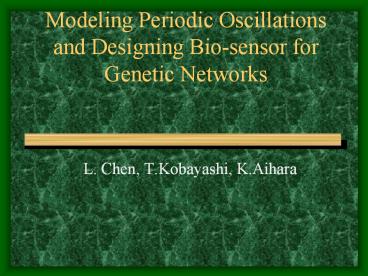Modeling Periodic Oscillations and Designing Bio-sensor for Genetic Networks - PowerPoint PPT Presentation
1 / 30
Title:
Modeling Periodic Oscillations and Designing Bio-sensor for Genetic Networks
Description:
Multiple Time Scales, Hysteresis and Delay. A Two-Gene Model. Singular Perturbation ... mammal, etc. Jumping Dynamics. ?Phage, etc. Mathematical Model. Boolean Model ... – PowerPoint PPT presentation
Number of Views:79
Avg rating:3.0/5.0
Title: Modeling Periodic Oscillations and Designing Bio-sensor for Genetic Networks
1
Modeling Periodic Oscillations and Designing
Bio-sensor for Genetic Networks
- L. Chen, T.Kobayashi, K.Aihara
2
Contents
- Background and Motivation
- Multiple Time Scales, Hysteresis and Delay
- A Two-Gene Model
- Singular Perturbation
- Relaxation Oscillator, Time-Delay
- Numerical Simulation
- A Three-Gene Model
- One-Gene Oscillator
- Bio-sensor
- Synchronization model
3
Rhythms in Living Organisms
- Mathematical Model
- Boolean Model
- Differential Equation Model
- Hybrid Model
- Etc
- Analysis
- Computer Simulation
- Stability Analysis
- Bifurcation Analysis
- Etc
- Periodic oscillation
- Circadian Rhythms, etc.
- Period Seconds ? Years
- Drosophila, Neurospora,
- mammal, etc
- Jumping Dynamics
- ?Phage, etc
Gene Network
Mechanism ?
4
Theoretical Models
- Enzymatic control process, Goodwin(1965)
- Negative feedback loop, Hastings, et al.(1977)
- Circadian oscillation in Drosophila, Goldbeter
(1995,1998) - Mathematical model of transcription, Keller(1995)
- Gene regulatory dynamics, Wolf et al.(1998)
- Switching dynamics, Smolen et al.(1998)
- Synthetic Toggle switch, Gardner et al. (2000)
- Repressilator, Elowitz and Leibler (2000)
- ?switch, Hasty et al. (2001)
5
Synthetic genetic oscillator
Repressilator by Elowitz and Leibler
6
Properties in Living Organizm and Motivation
- Time Scale Differences of Bio-reaction
- Transcription, Translation
- (sec ?
minutes ) - Binding, Multimerization, Phosphorylation
(msec ? sec) - Hysteresis and Switching Dynamics
- Dynamics Change Drastically at Certain State
- Long Time Lags in Living Organism
- Unknown Chemical Modification
- (msec ? minutes )
- Transportation (sec ? Hours )
Possible Mechanism for Oscillation ?
Effectiveness for Oscillation ?
7
Problems robustness of repressilator
- Irregular period
- irregular amplitude
- Failure of oscillation
Elowtiz et al., Nature, 2000
8
Purpose
- Robust Oscillator delay and noise
- --- hysteresis and time scale
differences - Sensitive Bio-sensor
- --- bifurcation
- Bio-modules as building blocks
- --- synthetic genetic networks
- (Negative feedback, frustration system,
competitive system)
9
A Two-Gene Model
p(t-t)
p(t-t)
kp
slow
Protein p
DNA sequences
Gene-P
Gene-Q
RERQ
RERP
fast
kq degradation
Protein q
q(t)
q(t)
q(t)
q(t)
10
Singular Perturbation
- Slow Subsystem for Scale t
- Fast Subsystem for Scale t
11
Relaxation Oscillation
Protein q
Protein p
12
Relaxation Oscillator
Theorem Assume that the system has only one real
equilibrium E(p,q). When time-scale difference
is sufficiently large, if J gt0, the system has a
periodic solution around E if J lt0, the system
has a stable equilibrium at E.
Time scale difference generates switching
dynamics and hysteresis creates oscillation.
Robustness to noise and parameters
13
Two-Gene System with Delay
There is a time delay for protein p. Equilibrium
is the same as the model without time delay.
14
Effectiveness of Time Delay
- Enlarge the stability region of oscillation
- Influence the period length
15
Delay Enhances Oscillation
Theorem When time-scale difference is
sufficiently large, if J gt0, the system has a
periodic solution around E for any t if J lt0,
the system has a periodic solution around E for t
gt t0 . Delay enlarges the stability region of
oscillation and periodic length.
16
Numerical Simulation(A limit cycle with and
without delay)
e0.01, t0.5
e0.01, t0
17
Time Evolution for e0.01
18
Limit Cycles with Parameter Variations
e0.001
e0.3
e0.25
e0.01
19
Robustness of Oscillation with Delay for noise
20
A Three-Gene Model
PR
PRM
cI
LuxR
LuxI
ai
Placlux0
ai auto-inducer
Protein p1 and p3 form a heterodimer to inhibit
gene-2. Protein p2 forms a homodimer to activate
gene-3 and inhibit gene-1
21
Relaxation Oscillation for Three-Gene System
Gene Ocillator Gene Switch
22
Mathematical Model
,
23
Bio-sensor by Bifurcation
- Saddle bifurcation jumping dynamics
- Singular homoclinic bifurcation (Hopf
bifurcation) equilibrium oscillation - Canard Orbit
- There exists only in parameter ranges
exponentially small - in relation to e when the equilibrium moves.
- Trajectory changes exponentially from equilibrium
to - full size periodic orbit.
- Bio-Sensor spiking and pulse
24
Bio-Sensor
?
Enlarge oscillation region
25
Relaxation-based sensor
Green Input
Red proteins.
concentration
time
concentration
time
26
Two-Gene Model (A)
27
12min change of Arc ? 120 min change of Cro
28
Numerical Simulation
cro
cI (temperature sensitive)
cI life-time 1min ?2min
cI life-time 4min ? 2min
cI
cro
mRNAcro
mRNAcI
29
Synchronization of Oscillators
CELL Oscillator ai
CELL Oscillator ai
Autoinducer
ai
CELL Oscillator ai
30
Conclusion
- Oscillator is constructed by time differences
- and hysteresis
- Periodic oscillation with switching dynamics
- Robust oscillator with delays and noise
- Exmples by two and three genes
- Bio-modules, e.g. switch, oscillator, bio-sensor
















![ESRT: Event-to-Sink Reliable Transport in Wireless Sensor Networks[Sankarasubramaniam et. al, ACM MobiHoc 2003] PowerPoint PPT Presentation](https://s3.amazonaws.com/images.powershow.com/6075243.th0.jpg?_=20201118051)











![Modeling MEMS Sensors [SUGAR: A Computer Aided Design Tool for MEMS ] PowerPoint PPT Presentation](https://s3.amazonaws.com/images.powershow.com/4532729.th0.jpg?_=20200927124)


